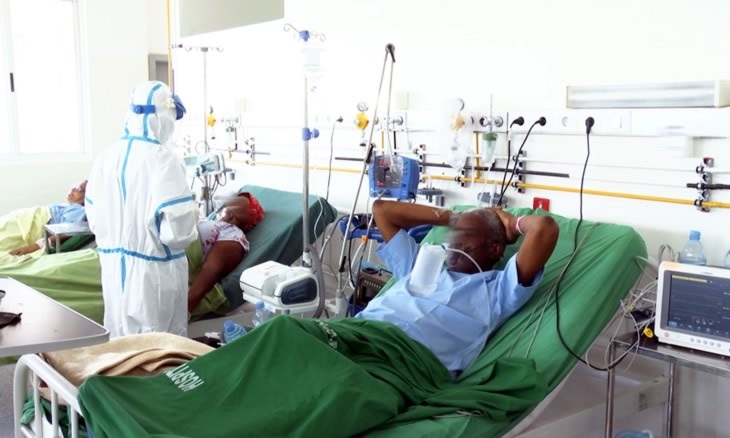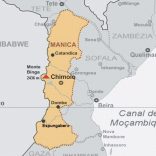Mozambique: More water for the population of Diaca administrative post
MISAU allows press visit to Polana Caniço isolation centre – to show the face of Covid-19

Photo: O País
At around 10:00 a.m. this Tuesday, journalists accompanied by a team from the Ministry of Health visited the Polana Caniço Covid-19 Isolation and Treatment Centre in Maputo city, where patients are fighting for their lives in the face of the new coronavirus pandemic.
It is the first time that the media have visited a unit where Covid-19 patients are hospitalised since the coronavirus outbreak in March.
Before accessing the ward, journalists were one by one dressed in the indispensable protective equipment needed in places with a high risk of infection.
The masks that the media professionals were wearing were replaced by the N95 (considered safe in a high risk context). They wore head covers, and their colourful clothes were covered by the hospital gowns and shoe covers.
Following green-painted marks, health technicians led the way down somewhat narrow corridors, and explained the procedures for hospitalisation right through to discharge.
The first procedure in the health unit is the reception of a patient. Patients arriving at Polana Caniço are left at the entrance, and often need wheelchairs because they can’t walk on their own.
Since the beginning of the pandemic, 56 of the total 118 deaths countrywide were registered in this unit, which currently houses 35 patients.
Patients hospitalised with Covid-19 in Polana Caniço breathe with the support of oxygenation machines.
The room is equipped with beds for initial screening.
“When the patient arrives, he is received by the team and then taken to the infirmary and, according to the patient’s age, he goes to paediatrics or the adult infirmary. Taking into account also the patient’s condition, he is taken to the intensive care room, if he is a serious or critical patient. And we have a ward for moderate cases, where those who do not require intensive care are taken,” explained Polana Caniço director Doctor Mariano Marengue.
In the intensive care room, the image is shocking. Men and women are lying on hospital beds, desperately gasping for oxygen, an important element in winning the battle against Covid-19.
Shortness of breath causes some patients to have seizures, and it’s the machines that help those patients breathe.
“In general, every patient in the intensive care room needs oxygen, whether it is low flow oxygen in small volumes, large volumes or ventilatory support,” explains Doctor Manuela Soares, internist at Polana Caniço General Hospital. Depending on the associated chronic pathologies, patients also receive appropriate follow-up. “If you are diabetic, we have to control arterial hypertension. The same happens if you are a patient with a chronic lung disease,” she adds.
Without a cure or a vaccine for Covid-19, the virus which brought these people to the hospital bed, other drugs are used, such as antibiotics and anti-inflammatory drugs to prevent the worst from happening.
So far, there has been no need to intubate.
“What we have is a patient receiving high-flow oxygen, which is a type of treatment which, if he continues to progress with his disease, may require intubation, but until now, there have been no intubated patients,” Doctor Soares says.
Also, at the moment, there are no patients needing to use ventilators. But if necessary, the Polana Caniço Isolation Centre has the devices and medication available.
“We have invasive and non-invasive mechanical ventilators which we can use for patients. So far, we have only used non-invasive ventilators, and we have not yet had the need to use invasive ones,” Doctor Mariano Marengue says.
The director says he has all the medicines necessary to treat Covid-19. “We never felt that we lacked medicines. We were able to mobilise all the drugs [we needed] to treat this disease.”
When the treatment starts to take effect, patients are transferred to a ward (for moderately ill patients), where at least three patients remain. If they do not show any more symptoms, they are discharged from the hospital, but remain in isolation at home.
“We have to keep an eye on the patient. He should not have symptoms for three consecutive days. The patient must not have a fever, difficulty breathing or low [oxygen] saturation,” the doctor explains.
After this phase, the patient is discharged, as “he no longer needs medication or oxygenation. He goes home, but remains in isolation until he completes the necessary days to take the test and get a negative result”.
Around 100 million meticais were spent transforming Polana Caniço General Hospital into a coronavirus isolation and treatment centre.
“The investment was in terms of infrastructure, equipment necessary to treat Covid-19 patients according to the World Health Organization protocol. We invested in oxygen because patients need it – it is vital to saving patients’ lives,” national director of Medical Assistance Ussene Isse details.
Ussene Isse stressed that the oxygen is ducted and available 24 hours without interruption. “We also have oxygen concentrators, which are small devices which take regular air and purify it to 90-95% oxygen. They serve as a defence and safeguard in case the system should fail.”
Other investment concerned food, reinforcement of human resources and protective equipment for health technicians. And because Covid-19 numbers are rising, health technicians warn people to take the disease seriously and comply with all prevention measures so as not to overload the National Health System.
A total of 279 Covid-19 patients passed through the Polana Caniço Isolation Centre, 190 of whom have been discharged. The average number of hospitalisations is now five patients per day.
By Dario Cossa












Leave a Reply
Be the First to Comment!
You must be logged in to post a comment.
You must be logged in to post a comment.